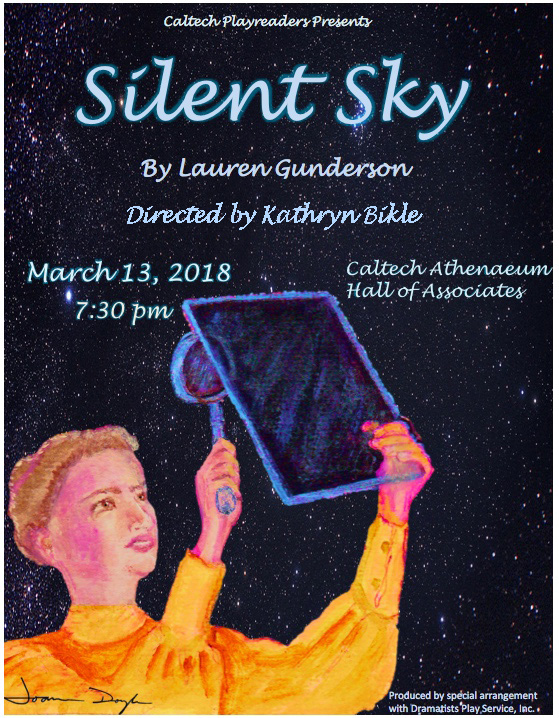Tuesday, March 13, 2018
Silent Sky by Lauren Gunderson
Directed by Kathryn Bikle

A Note from the Director
Annie Jump Cannon, Williamina Fleming, and Henrietta Swan Leavitt are three of the astronomers featured in the fascinating and moving new book by Daval Sobel, The Glass Universe: How the Ladies of the Harvard Observatory Took the Measure of the Stars. These women were called "computers," as their job was to look through glass photographic plates which could display the light from 50,000 stars, note a star's brightness (or magnitude), and compute its location in the sky. Highly intelligent and well-educated in mathematics, astronomy, and physics, these "computers" were paid only 25 cents an hour (comparable to a servant's pay) and worked seven hours a day, six days a week in a tiny, dingy office. Although they were not permitted to look through the telescopes because they were women, their calculations laid important groundwork for future astronomers and led to some of the most important astronomical discoveries.
One of the most famous computers was Annie Jump Cannon, hired at the Harvard College Observatory in 1890. Her job was to devise a classification system for all the known stars in the sky based on their spectra, and her system is still used today; over the course of her life she classified the spectra of over 350,000 stars. Williamina Fleming discovered more than 300 variable stars and, in 1899, became Harvard's first curator of astronomical photographs. And Henrietta Swan Leavitt discovered more than 2,400 variable stars, about half of the known total in her day. Leavitt determined the relationship between luminosity and period of fluctuation for a class of pulsing variable stars called Cepheids, leading to her most important contribution to the field and one of the cornerstones of modern astronomy: the "cepheid variable period-luminosity relationship." By relating the period of a given star's brightness cycle to its absolute magnitude, an astronomer could calculate its distance from Earth. In the words of George Johnson, author of the book Miss Leavitt's Stars, with this discovery Leavitt became "the woman who discovered how to measure the Universe." Leavitt's discovery was so important that in 1924 she was nominated for the Nobel Prize; sadly, Leavitt had died of cancer in 1921, and the Nobel Prize is not awarded posthumously.
Playwright Lauren Gunderson has written many science-based plays, including Emilie: Le Marquis du Chatelet Defends Her Life Tonight, which we performed at Playreaders in 2013. In 2016, Gunderson was the most produced living playwright in America! http://laurengunderson.com/
References: The Glass Universe: How the Ladies of the Harvard Observatory Took the Measure of the Stars by Dava Sobel; "From 'Computer' to Astronomer: The Role of Women in Astronomy" by Melissa Joskow, Smithsonian National Air and Space Museum; "A Science Odyssey: Henrietta Leavitt, 1868 - 1921" on PBS.org; Miss Leavitt's Stars by George Johnson; and "Henrietta Leavitt: Celebrating a Forgotten Astronomer" by Gael Mariani in AAVSO, the American Association of Variable Star Observers.
The setting: 1900 - 1920. The Leavitt family farm in Wisconsin; Harvard College Observatory 2nd floor offices; Henrietta's home in Cambridge, MA.
Cast of Characters:
| HENRIETTA LEAVITT | an Astronomer who traveled to Harvard to work |
| MARGARET LEAVITT | Henrietta's sister, a musician who stayed at home to take care of the family |
| PETER SHAW | an astronomer, assistant to the Director of Harvard College Observatory |
| ANNIE CANNON | mathematician and astronomer, something of a legend in Henrietta's office |
| WILLIAMINA FLEMING | Harvard's first curator of astronomical photographs |
Produced by special arrangement with Dramatists Play Service. Inc.
|



